The Holy Grail of Restoration
Dust has blown over the Sinai’s denuded landscape for so long that it is hard to imagine it as the biblical “Land of Milk and Honey.” Yet satellite images and other evidence tell another story.
Seen from space, the Sinai Peninsula looks like a beating heart, with arteries and veins flowing to nurture the body. Clues from geologic time, evolution, and human history are all etched on the exposed soils. If one knows how to read this landscape, it is possible to see that rivers flowed through the Sinai over vast evolutionary time. Even now, there are periodic flash floods when, because of the degraded landscape, rain that would nurture the land flows immediately into the sea.
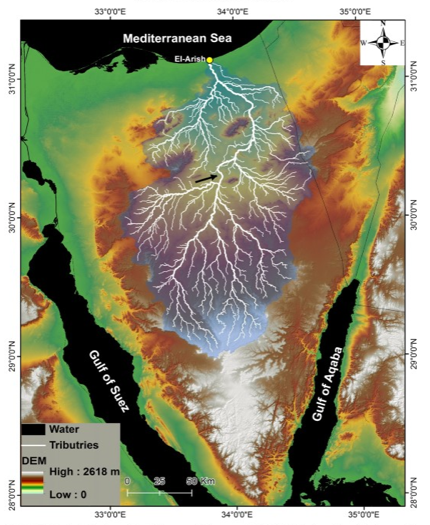 This strategic land is literally at the heart of early western civilization, situated at the intersection between Africa, the Mediterranean, and the Middle East. Figuring prominently in the cosmologies of western religions, the Sinai has had an immense impact on human civilization in both historical and contemporary times. Some of the earliest human mining of minerals took place in the Sinai. Repeatedly emerging cultures vied for this prized real estate. Humanity has been moved by poetry and art emanating from the region, but conflict and suffering have emerged as well.
This strategic land is literally at the heart of early western civilization, situated at the intersection between Africa, the Mediterranean, and the Middle East. Figuring prominently in the cosmologies of western religions, the Sinai has had an immense impact on human civilization in both historical and contemporary times. Some of the earliest human mining of minerals took place in the Sinai. Repeatedly emerging cultures vied for this prized real estate. Humanity has been moved by poetry and art emanating from the region, but conflict and suffering have emerged as well.
For several hundred generations, humans have altered the habitat of living aquatic, plant, animal, bird, microbial, and fungal communities with devastating effects to the region’s ecology. Over historical time, the vegetative cover and evolutionary biodiversity of the Sinai has been in large part lost. Imagine the importance if it were possible to restore the region to ecological health.
Malik Boukebbous is a very capable, practical man in his late forties for whom managing large engineering works is normal. His experiences span the globe and many are of monumental scale. Of Belgian and Algerian ancestry, Malik has great empathy for the suffering of many people in the Middle East and beyond. The mixture of successful engineering at huge scale and personal understanding of the region’s psyche make Malik a natural bridge between cultures. Well known in Egypt as project manager for the giant Belgian dredging company DEME, working on the enlargement of the Suez Canal, Malik was approached in January 2016 by an official of the Egyptian government and asked if his company could help to restore Lake Bardawil in the Northern Sinai.
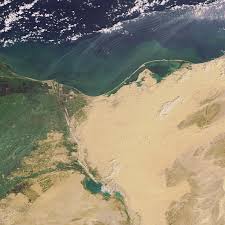
Protected from the Mediterranean Sea, inside a natural bay of accumulated coral deposits and marine sediments, Lake Bardawil on the northern coast of the Sinai Peninsula was evolutionarily and historically an abundant 40-meter-deep aquatic nursery. Now with a depth of less than two meters, the water hyper-saline and much hotter, the lake is only a shadow of what it once was. Fishing communities living and working along the lake’s banks for as long as anyone can remember can no longer count on catching fish to feed their families or make a living. The fishermen and most everyone else in the Sinai essentially have no gainful employment. Without legitimate work for the people to do, the Northern Sinai has become a seriously dangerous place.
To answer the question posed by the Egyptian government, Malik asked colleagues about who would be able to help create an integrated restoration design for Lake Bardawil from ecologic, economic, and social perspectives. The company referred Malik to Matthias (Ties) van der Hoeven, a morphological engineer in his mid-thirties who had worked on several projects in various parts of the world, including the construction of an artificial island in the Emirates. Earlier in his career, as a newly minted hydraulic engineer just out of University, Ties had gained valuable experience working as a consultant with a team of innovative coastal engineers before being hired by DEME.
Ties had made a bit of a stir when he was first hired by DEME by criticizing practices in the offshore dredging industry. One can imagine risk-averse engineers working on gigantic infrastructural or extraction projects reacting to a youthful engineer telling them they were doing it all wrong. The top managers heard about the disruptive young man and called him in to headquarters and asked what he was doing criticizing the work of seasoned engineers in the field.
Ties proceeded to tell the company’s management that from what he could see, the dredging industry was trying to go extinct. He told them that their current procedures would cause huge ecological impacts, constant legal disputes, and the loss of huge amounts of money. He added that there was another way to do the job. Interestingly, the top management at that time knew the industry was struggling with costly legal disputes, facing strong criticism of its environmental impacts and the potential of enormous fines. Instead of kicking the kid out and siding with the dredging cowboys, they asked him what he suggested they do.
Never shy, Ties, representing the thoughts of many younger engineers, told them that the company should deploy large numbers of inexpensive sensors on all equipment above and below the ocean’s surface, on vessels, on special grids of buoys in the water and to use instruments and cameras above and below the waterline to collect comprehensive data on wind, currents, sediment movements, temperature, pH, and all other relevant information. Ties explained that the data and images from these devices could be streamed in real time to a computer. The data would provide plotting points on a multi-dimensional graph representing real outcomes from all measured criteria. With this network in place, all decisions on dredging could be adjusted precisely based on analysis of the actual measured impacts. He called this “Proactive Adaptive Management.” The leaders of the company were impressed enough to at least try it. After DEME piloted a project using this method and realized that it could save millions of Euros as well as much embarrassment, there was no going back. Spurred on by a new generation of engineers who cared about the Earth and were dedicated to measuring the impact of their actions, the dredging industry took an important evolutionary step.
When Malik and Ties began to collaborate, sparks began to fly in a good way; together they were stronger, as if each provided a missing part of the other’s personality. Most importantly, they both wanted their work to benefit the Earth and human civilization. Ties began to consider what could be done to bring Lake Bardawil back to ecological health and productivity. Recruiting allies including colleagues within DEME—Arjan Mol, Frederik Goethals, Pierre De Geest, François De Keuleneer, and Maarten Lanters, a coastal engineering student at Ties’ alma mater, Delft University—along with Josien Steenbergen and Edward Schram, researchers at the Institute for Marine Resources and Ecosystem Studies (IMARES) at Wageningen University, Ties and this growing team began to envision what sorts of interventions could restore the ecology and provide peaceful occupations for the communities near the lake and throughout the Sinai. Ties and the team shared their thoughts with Malik, who then discussed them with his superiors in the company and with the Egyptians, all of whom became increasingly interested in what was being considered.
The team began to gather huge amounts of data on the region. They studied the geography, the tides, the currents, the rainfall, the aquatic life, the terrestrial biodiversity, wind speed, wind direction, and historical weather patterns. They looked at interventions made in the lake in previous decades and the results, noting that opening inlets to allow for a controlled increase of the tidal inflows while cautiously dredging the lake to increase the depth would result in three immediate ecological gains. First, the concentration of salts in the water would be lowered; second, the temperature would be reduced; and third, the fish in the lake would rapidly increase in size and number. Their research also suggested that improving the ecology would significantly benefit the local population, reversing the decline in the fishing industry and adding to food security, employment, and the much-needed emergence of a legitimate economy in the Sinai.
At this point, the design exercise had answered the questions that had originally been asked of Malik by the Egyptian government official. Perhaps most people would simply have declared victory and moved on; but as the datasets concerning the lake and the region continued to increase and were analyzed, Ties began to notice the potential of positive feedback loops being triggered that suggested transformational changes would occur if a certain progression of interventions were implemented. This spurred him to increasingly impassioned analysis. As the team began to run big data Weather Research and Forecasting (WRF) models on computers, certain scenarios began to show changes that pointed toward extremely compelling potential outcomes for the Middle East, North Africa, and the Mediterranean. These hinted at a massive breakthrough in understanding, explaining many of the historical outcomes in the region.
Ties began to wake in the middle of the night and find that he was in the midst of drawing detailed maps of North Africa and the Middle East on the floor. His family and friends were concerned that he wasn’t eating or sleeping regularly and was becoming more obviously hyperactive. Around this time a friend, Eric van den Lockant, asked Ties, “Did you see the VPRO documentary Green Gold? Have you ever heard of the Loess Plateau, John D. Liu, Willem Ferwerda, or the Commonland Foundation?”
Green Gold (also called Regreening the Desert), if you haven’t seen it, is a film I made with Dutch Public Television for a series called Tegenlicht or Backlight about the long-term inquiry I have been working on for most of the last three decades. The film contains documentation of ecosystem restoration worldwide, including in China, Ethiopia, Rwanda, and Jordan. It follows other films I’ve made on the subject, including The Lessons of the Loess Plateau and Hope in a Changing Climate. Ties, excited with his own work, was not interested in some documentary he had never heard of, but his friend didn’t give up. Eric finally downloaded Green Gold and forced Ties to sit down and watch it. The initial screening of this film caught Ties’ imagination and he began to watch it over and over again.
My own journey has led me to understand that it is possible to rehabilitate large-scale degraded landscapes, including restoring vast areas degraded over historical time. I have also learned that while this is possible, it is in no way easy. There are certain natural principles that it is necessary to understand—including that biodiversity, biomass, and accumulated organic matter are central to evolutionary outcomes and ecological function. When humans shift away from this scenario to degradation of these essential processes, it inevitably leads to ecosystem collapse.
When a region is de-vegetated—whether from greed or ignorance or both—many natural evolutionary processes are altered, causing several measurable and predictable outcomes. It is simply cause and effect. All living matter on the Earth is part of a web of life that has taken a lifeless molten rock surrounded by what for us are poisonous gases, and over enormous time, through continuous photosynthesis, transformed it into a beautiful planetary garden with an oxygenated atmosphere, a freshwater system, rich fertile soils, and amazing biodiversity. My observations and the results of numerous studies show that when you lose the vegetative cover, respiration through photosynthesis is reduced; the surface temperature and evaporation rates massively increase, causing spiraling negative feedback loops that can and do destroy functional ecosystems. When these negative trends continue for thousands of years, you end up with conditions very similar to those in the Sinai.
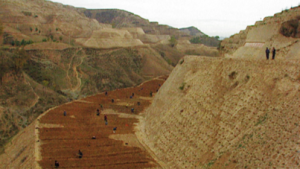
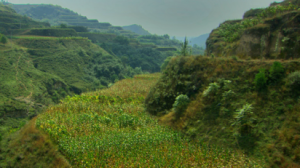
Left picture: Ho Jia Gou in Shaanxi, early Sept. 1995 | Right picture: Ho Jia Gou, Sept. 2009, from Hope in a Changing Climate, broadcast initially on the BBC World
My studies in China and worldwide suggest, at the very least, that it is possible to restore ecological function in many regions of the world. After supporting my early study for some time, the World Bank and the British Department for International Development (DFID) made some choices that propelled my thinking to a larger stage.
This began when I was assigned to make a scientific presentation to the Yellow River Forum in 2005. After dropping out of University to be a television cameraman, I became an accidental scholar working with a number of universities and research institutes, including the University of the West of England, Rothamsted Research, Reading University, George Mason University, the International Union for the Conservation of Nature (IUCN), and the Netherlands Institute of Ecology. That first scientific presentation was the start of a trajectory that has led to hundreds of presentations over the years.
One of the most eventful of these lectures took place in 2009 at the Tällberg Forum in Sweden. A very high-level audience, including an Undersecretary General of the United Nations, the Head of the European Environment Agency, the Chairman of the IUCN, and 500 of their closest friends were forced to listen to me. The Tällberg Forum in 2009 was also very notable as Johan Rockström of the Stockholm Resilience Centre was introducing the concept of “The Planetary Boundaries,” which was then published in a special edition of Nature magazine. This important paper can be seen as an increasingly dire warning updating the “Limits of Growth” that the Club of Rome introduced in 1972. This analysis is now widely accepted and punctuated by the latest report of the Intergovernmental Panel on Climate Change (IPCC) that warns of potentially catastrophic consequences if we don’t immediately act to reduce rising global temperature averages.
At the Tällberg Forum, among the luminaries, I felt very much like an unknown small fish. I spoke after former Norwegian Prime Minister Dr. Gro Harlem Brundtland, who had also been the head of the World Health Organization. Dr. Brundtland is well known for being asked by the Secretary General of the United Nations, in 1983, to chair the World Commission on Environment and Development that published an important policy paper widely known as the “Brundtland Report.” This important statement of global human intention included the first time that “Sustainable Development” was mentioned in international diplomacy. This was, for me, a very important turning point because through direct personal observation and documentation, I was convinced that restoration was possible but was beginning to feel that I was a lone voice calling in the wilderness about it.
My presentation at the Tällberg Forum had a very interesting effect. It fundamentally changed the tenor of the conference from one of resignation bordering on despair to one of hope and excitement. As fate would have it, in the audience was Willem Ferwerda, then the country director of IUCN Netherlands, who has become a friend and a champion of restoration. Following my presentation about the rehabilitation of the Loess Plateau, and how China’s example had motivated massive changes in Ethiopia and Rwanda and the potential of ecosystem restoration on a planetary scale, Willem came to me and said, “We have to work together for the rest of our lives.” My answer was, “Ok, but it’s not long enough.” Since that time, Willem and I have been working together. A few years after we met, Willem left IUCN and created the Commonland Foundation in order to take ecosystem restoration mainstream.
As a film, Green Gold brought together many ideas that I had wanted to communicate for quite some time. When Ties saw the film, he felt compelled to contact someone at the Commonland Foundation. On May 10, 2016, Ties sort of stormed the Commonland office with Malik, Pierre De Geest, and Delphine Van Goethem. They presented the initial design for the restoration of Lake Bardawil and the Sinai to Willem, John Loudon, and me.
The presentation made by Ties and his colleagues was very well thought out and wonderfully hopeful. Since documenting the Loess Plateau rehabilitation where the pilot project restored an area of 35,000 square kilometers, most other restoration projects have seemed small to me. Ties and his team’s vision for the restoration of Lake Bardawil and the Sinai did not seem small. Having studied for months, Ties and his team had begun to uncover and accumulate clues from many other studies. Complex ecological phenomena, which in isolation might seem like “far out” facts, can reveal logical patterns that are understandable. They show cause and effect that can explain many of the outcomes that we see today. This type of information is especially meaningful when you and your colleagues are in possession of a vast engineering capability and are used to deploying it for commercial reasons. It apparently gives one a different understanding of what is possible when you think it is normal to build artificial islands or double the size of the Suez Canal. To say the least, there was great excitement when Ties and his team shared their work.
The datasets that the team collected included studies analyzing pollen samples suggesting that over evolutionary time it was normal for ancient biodiversity from the Indian Ocean region to migrate into and live in North Africa, the Middle East, and the Mediterranean. The evidence also showed that the trend of biodiversity flowing north into the region reverses at a point several thousand years ago. What exactly changed to stop the wind, water, and biodiversity from flowing north?
Very quickly, Ties and I traveled to the Loess Plateau in China so he could fully understand the scale of the restoration and regeneration that had been accomplished there. We drove many hours through thick, diverse forests that cover what 25 years ago was bare earth. We sat outside of our cave hotel in Yan’an when a huge rainfall event drove us back indoors. We were forced to consider what it meant when you watched barrels of rain come down in an area that had been thought by most people to be a desert only 20 years before. To see that this water was absorbed into the biomass and into the intact soils and that these were the methods that had reversed traditional desertification was clearly apparent. We walked by the rapids on the Yellow River as I explained the role of microbes in evolution and their relationship to the oxygenated atmosphere, soil fertility, and carbon sequestration. Ties hopped around on the rocks and pointed. Then he stopped in his tracks and stared at a puddle. There, in small stagnant pool, algae were growing, emitting tiny bubbles of oxygen—not only illustrating, but actually breathing life onto the planet.
That night, Ties showed me one of his drawings of a water catchment from the Sinai, explaining his thoughts. I stopped him and asked if he knew who Millán Millán was. When he said no, I showed him a picture that Professor Millán had made some years before and showed me when I first met him. It was almost identical to Ties’ drawing. Professor Millán’s drawing is of the Spanish landscape rising north from Valencia, and Ties’ drawing is of the Sinai rising from the Mediterranean south toward Mount Catherine—but without a title and compass bearings, you could barely tell them apart.
I introduced Professor Millán Millán to Ties, and they began to communicate and meet. Professor Millán’s work spans decades as one of the world’s premier meteorologists working in Spain, Canada, Holland, Germany, the EU, and the Mediterranean. With Professor Millán’s help, Ties and the team began to learn more about the relationship between natural vegetation and temperature, cloud formation, and rainfall. The effects of deforestation and de-vegetation of the Sinai thousands of years ago can be seen in hindsight, and we can surmise how the ecosystem reacted and the function decreased from human impact. Without vegetation cover and normal evaporation and transpiration, the temperature on the soil surface massively increased. I have seen this in measurements the Chinese have made that show the same thing and through the experience of looking at natural and degraded systems worldwide.
Ties learned from Professor Millán that thermal updrafts caused by very high temperatures on de-vegetated landscapes drive moist air high into the atmosphere where it cannot rain, but instead becomes an even more serious greenhouse gas than CO2. As one looks closely, one begins to see how the Sinai de-vegetation over time led to dehydration of the biome and attendant higher surface temperatures that caused an inversion in wind direction. These extremely high temperatures caused by human beings de-vegetating this specific region reversed the wind, which began to pull moisture-laden air to the south. If you play a scenario forward from 7000 years ago of a vacuum pulling moist air out of North Africa, the Middle East, and the Mediterranean, the end result is exactly what we have right now. It seems to me that what Ties and his team saw is very probably the cause of desertification in North Africa, the Middle East, and the Mediterranean.
Satellite images of the Sinai are extremely revealing. They show the remains of numerous rivers flowing down out of the mountains. It looks like the beating heart and the veins of a body. These are etched into the stone; the amount of water and the force that did this is clearly enormous. Satellite images of mineral deposits also show that the drying of the Sahara took place very rapidly. This is clearly visible in sediment core readings as well. We even know when this took place. We are forced to contemplate why the areas that were once known as “the Fertile Crescent,” “the land of milk and honey,” and “the Garden of Eden” have become war-torn deserts. If this thesis is proven, then we are looking directly through the eyes of our ancestors and watching as they cause the desertification of the cradle of civilization of the western world.
It is important to note that religious teachings and evolutionary science-based analysis both posit that we humans emerged in Paradise. The Earth provides us with all that is needed for life to flourish. When studying how this came about, the best evidence we have suggests that the Earth formed around 4.5 billion years ago (give or take 100 million), when cosmic dust orbiting the Sun solidified into a molten rock surrounded by what for us are poisonous gases. As the crust of the planet cooled, microbial life emerged and began to differentiate. The planet’s violent crucible eventually cooled enough for photosynthetic living beings over prodigious time to transform the Earth into a beautiful garden with an oxygenated atmosphere, a freshwater system, fertile living soils, and wonderful biodiversity.
Looking back and studying the ruins of once great civilizations, we may be forgiven for thinking that our history is long. However, in relation to geological and/or evolutionary time, human history is quite sudden, short, and brutal. Over what little history we humans do have, it is clear that we often behaved as a murderous gang, terribly mistreating each other and massively changing Earth systems in quite dangerous ways. History is often taught as if those who most successfully brutalized, killed, and enslaved others were somehow the winners. From another perspective, it seems obvious that in violence and war, there are no winners. We all lose.
As the design team at DEME went further with an emerging vision of what was possible in terms of ecological restoration using the existing industrial capacity combined with ecological understanding, the corporation began to contemplate whether its future might be very different than its past. Looking at the options—extraction, the petroleum industry, the military-industrial complex, and just large engineering in general—one could consider this industry as archaic megafauna that is not really suited to a new reality that is more caring, egalitarian, and sustainable.
But perhaps we need to look again. What if this capacity to create change at enormous scale tempered by consciousness and mutual benefit was exactly what was needed? What if this power could be channeled toward regenerating degraded landscapes? Suddenly, part of the company began to see its future could be one that regenerates natural systems instead of one that destroys them. This change in intention is central to the evolutionary step that human civilization is called to take at this time. This type of thinking could provide a pathway for this and other companies to create a new holistic, sustainable industrial reality for the future.
Since we met, Ties and I have reconnected with some very experienced people who I had met earlier on my inquiry. These include Professor Li Rui, a Chinese scientist who has spent his entire working life on Earth restoration; Professor Tim Flannery, the famous Australian scientist and author of several books, including The Weather Makers; Daniel Halsey, a designer, trainer, and author who has been designing and implementing perennial polyculture landscapes; Dr. Charling Tao, a renowned physicist, activist, and friend; and Dr. John Todd, who has been designing constructed wetlands for decades and is considered by many to be the father of the field. Many others in Holland, Belgium, and beyond have begun to co-create a future that—instead of destroying the systems we rely on for life through ignorance and greed—restores them with consciousness and generosity.
A vision has begun to emerge from the growing understanding that by carefully dredging inlets from the Mediterranean Sea, it is possible to quickly reduce the salinity and the temperature of the water in Lake Bardawil. These actions will result in an increased tidal basin that will lead to significant and sustainable increases in the amount of fish, helping revive the traditional fishing industry and creating hope that things can get better. Dredging carefully to further deepen the lake and moving the materials from the lake onto the land allows for a number of positive developments both in the lake and on land. These include growth in calcium carbonate from growth of aquatic life; increased sea grasses; expanded reed beds in the lake; and a vast potential for soil formation through the introduction of microbial communities, fungi, and organic material on the land.
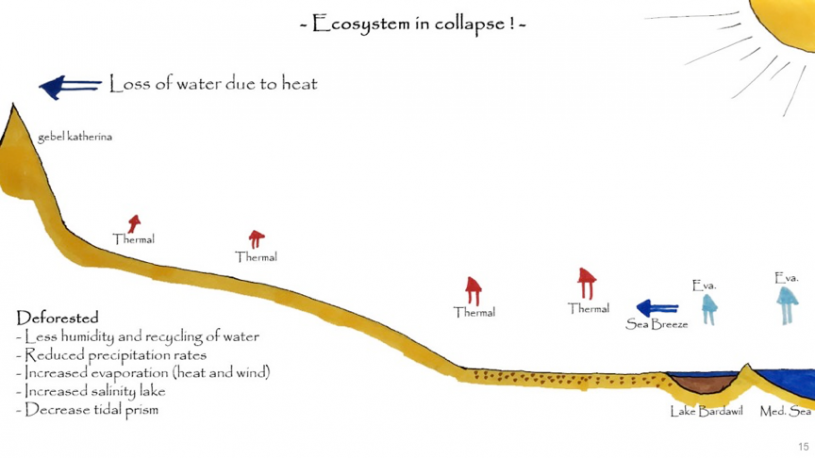 Consciously aligning human behavior with ecological systems over larger and larger areas of the marine and terrestrial environment can lead to further positive developments. The use of marine sediments to rapidly grow organic soils could change the fertility, productivity, and moisture retention in the Sinai. Massive propagation and planting of grasses, bushes, and trees will sequester carbon in both the biomass and the soil, which will physically lower the temperatures on the surface of the Earth. Lowering the temperatures will have a massive impact on evaporation and allow more water to be captured in the biomass and soil organic matter, helping to recharge the localized hydrological cycle. All of this will lead to positive feedback loops, further increasing moisture cycling, vegetative growth, and the return of biodiversity. To achieve this requires the creation of meaningful jobs that serve the local interest while simultaneously helping to address the most serious problem that human civilization has ever faced: the potential of runaway climate change. There is simply no doubt that these ecological improvements will positively influence the human social situation in the Sinai.
Consciously aligning human behavior with ecological systems over larger and larger areas of the marine and terrestrial environment can lead to further positive developments. The use of marine sediments to rapidly grow organic soils could change the fertility, productivity, and moisture retention in the Sinai. Massive propagation and planting of grasses, bushes, and trees will sequester carbon in both the biomass and the soil, which will physically lower the temperatures on the surface of the Earth. Lowering the temperatures will have a massive impact on evaporation and allow more water to be captured in the biomass and soil organic matter, helping to recharge the localized hydrological cycle. All of this will lead to positive feedback loops, further increasing moisture cycling, vegetative growth, and the return of biodiversity. To achieve this requires the creation of meaningful jobs that serve the local interest while simultaneously helping to address the most serious problem that human civilization has ever faced: the potential of runaway climate change. There is simply no doubt that these ecological improvements will positively influence the human social situation in the Sinai.
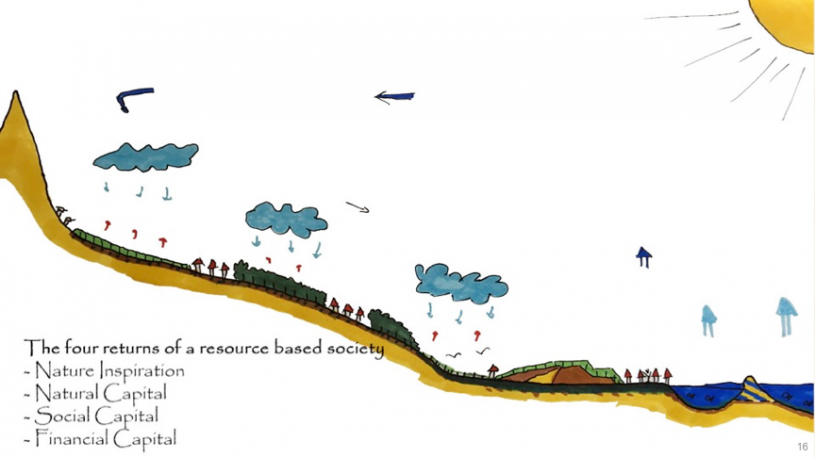
Carrying the analysis further, one begins to wonder: What would happen if these actions could reverse the causes of desertification in the region? If it were possible to stop the vacuum effect sucking moisture-laden air into the high atmosphere and pulling it to the south, would the inverse be to return the winds flowing north over the Sinai? Could this mean that the moisture-laden air coming from the Indian Ocean would return to the entire region? Could it be possible to rehydrate the dehydrated biome in the Sinai? Might it be possible to bring back the evolutionary outcomes that created the Garden of Eden?
The siren song of restoring the cradle of Western civilization to ecological health has firmly captured the hearts and minds of several talented people. Committing to the call to blend industrial capability with ecology has led Ties, Maddie Akkermans-Gockel, and Gijs Bosman to create a holistic engineering firm called The Weather Makers. The name is inspired by Professor Tim Flannery’s book that posits that humanity has already become weather makers, but not consciously. What the new Weather Makers show is that it is possible to make our industrial impact conscious and nurturing instead of destructive. This is a necessary next step toward sustainability and survival for humanity.
The Weather Makers thesis has been shared with the main science bodies in the Netherlands, the Dutch government, the Belgian government, the International Center for Agricultural Research in the Dry Areas (ICARDA), the World Bank, Wetlands International, the RAMSAR Convention Secretariat, and several other international experts in the field. In each case, there has been an enthusiastic response because the thesis that the Weather Makers have presented is such a plausible and innovative idea.
Functional living ecosystems are formed of diverse life forms in symbiosis. It stands to reason that if human systems seek to emulate natural ones, that these will be extremely complex, decentralized, and interactive. The initial design for the Sinai is a very good start that immediately recognizes relationships between organic material and hydrology, temperature differentials and wind speed, direction and altitude, microbiological interactions with geological minerals, organic growth of vegetation and soils, and the importance of respiration of plants and animals in the regulation of weather and climate.
Several of the concepts in the Weather Makers thesis are groundbreaking. The Weather Research and Forecast modeling suggesting that fundamental shifts in wind patterns could be brought about by restoration of the entire Sinai is of huge importance. The strategic use of marine sediments on land combined with microbial and fungal inoculation has very large potential for the protection of coastal regions. Creating vast numbers of meaningful jobs for marginalized people has the potential to reduce instability and promote peace. The overall intention of the project has the potential to show the global industrial complex how to pursue regenerative and peaceful pursuits, thus ending pollution and degradation—making holistic engineering central to the future of human civilization.
This thesis advocates transformational change. These changes are applicable and relevant not only in the Sinai, they are needed for the entire region and the world. Transformation is tantalizing because it is possible. If we have this as our intention, then we can make it happen. However, transformation is complicated because the current global market economy based on extraction, manufacturing, and buying and selling simply does not value people who do not contribute to the global transactional economy, even while valuing criminals who plunder the Earth’s resources and oppress billions of innocent people. How to resolve this contradiction is central to human efforts at regeneration. Answering this dilemma could lead us to the restoration of the entire planet.
We have grown so used to believing that things we produce, buy, and sell are the basis of the economy, it is hard to imagine that actually the wind, rain, and air are more valuable. Let us take a deep breath and ask if we are about to destroy our civilization, what is most precious? In a situation where climate change threatens our existence, what do we think is the value of natural climate regulation?
Following this thesis is like seeking the Holy Grail. The vision that we can mend our collective broken heart and live again in the garden is beautiful and compelling. If this is even remotely possible, we are obligated to take on the challenge.


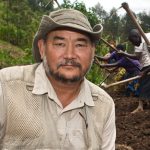
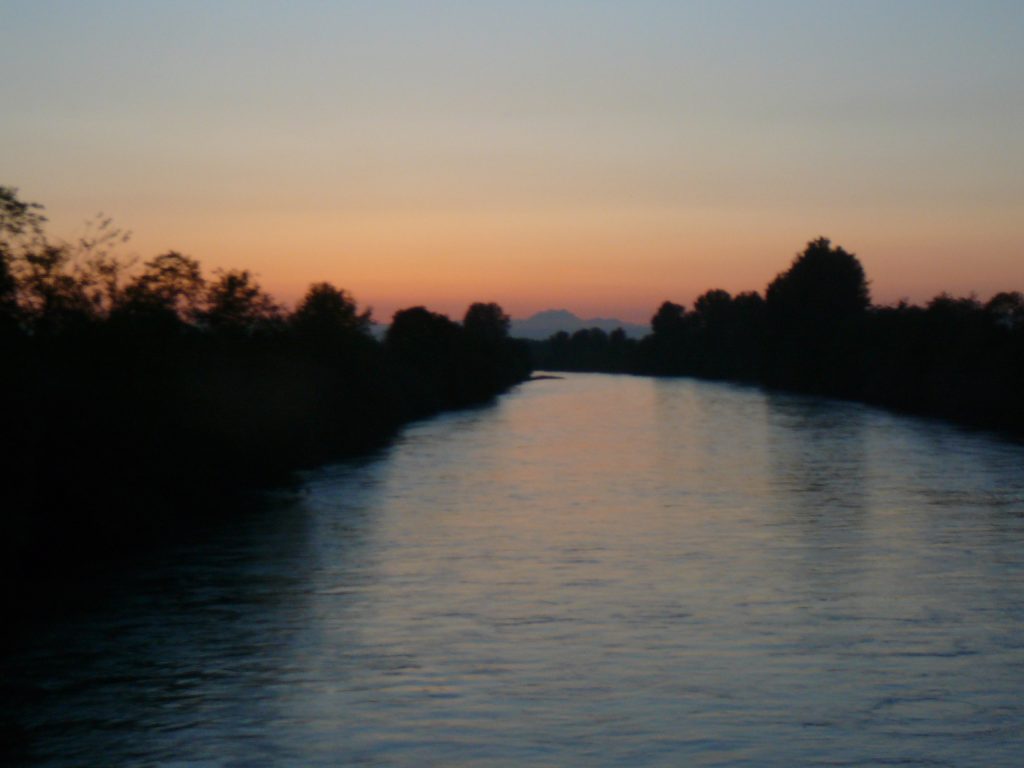
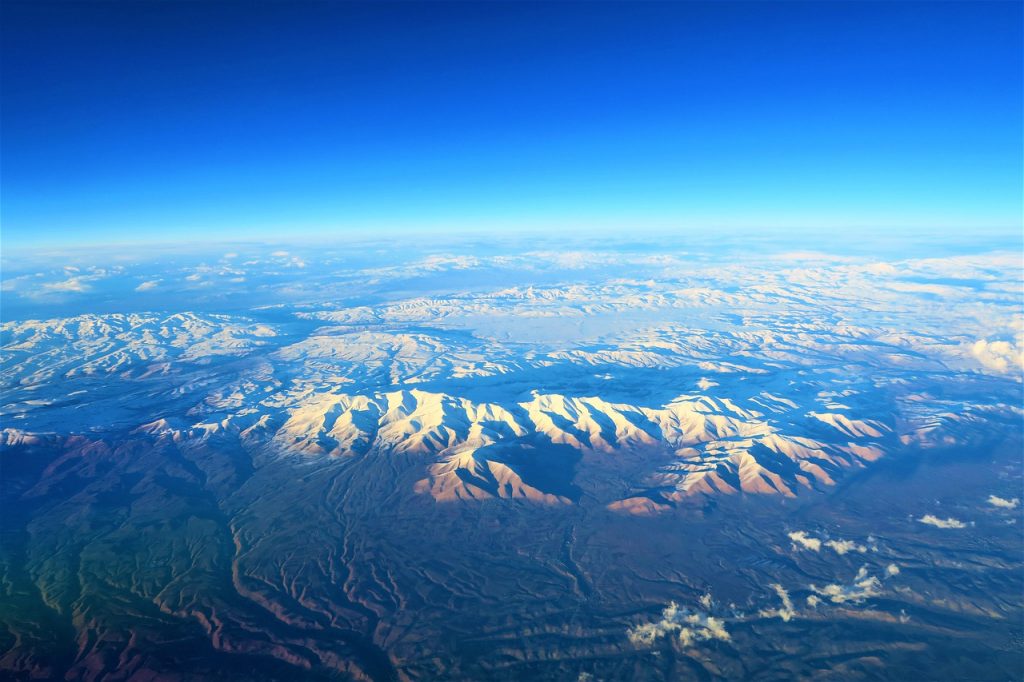
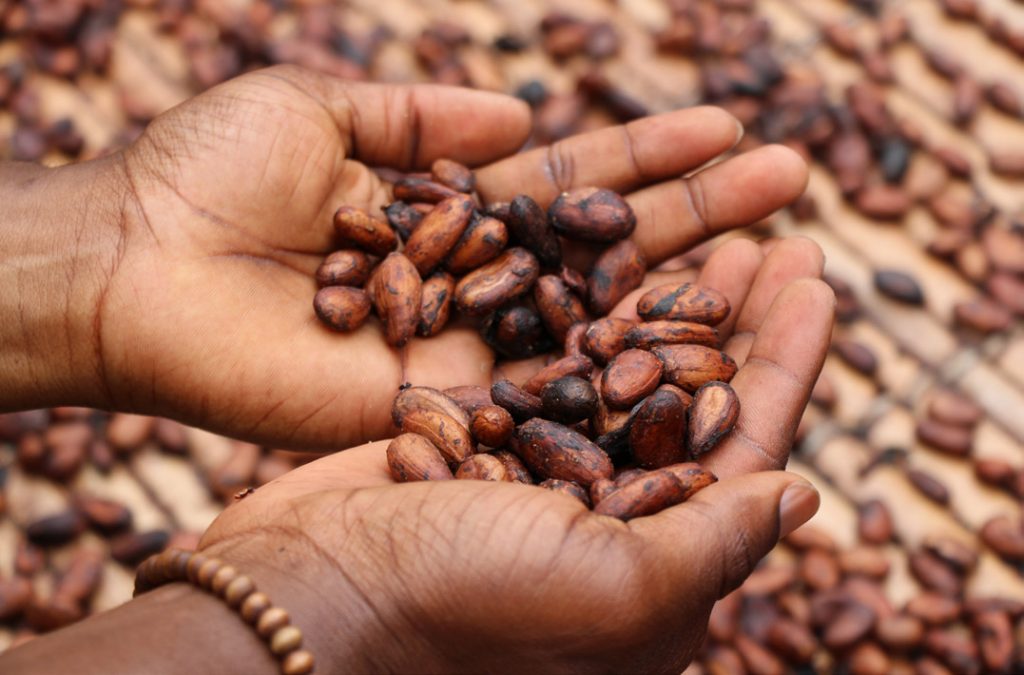
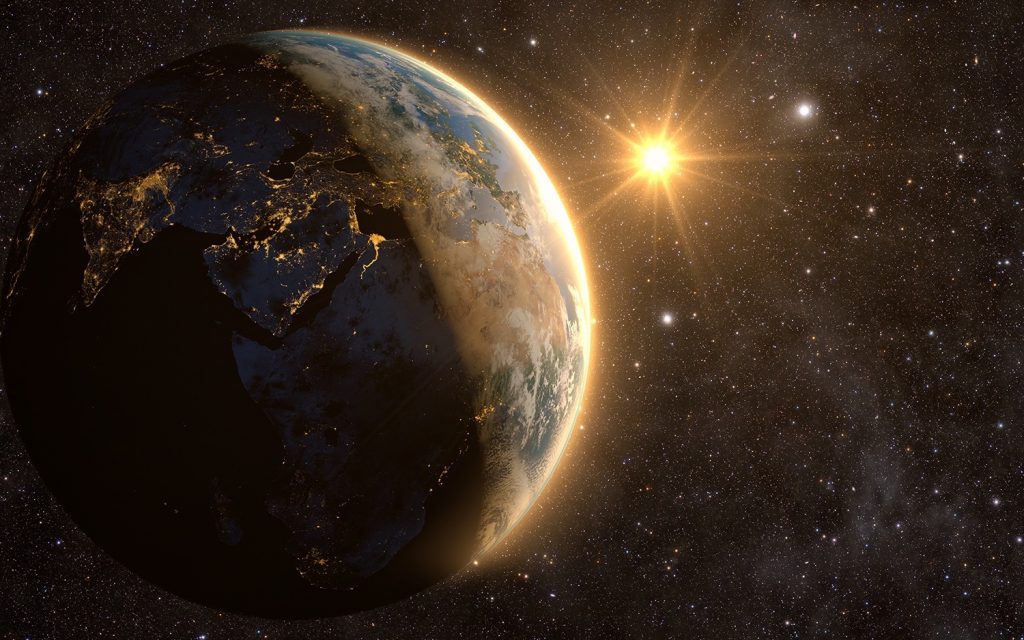
Dear Friends: I hope that if this essay has meaning for you that you will share it widely. We must work together as a species on a planetary scale. We can empower millions immediately to work in Ecosystem Restoration. This is much more valuable than anything else that can be done. Please share the link: https://www.kosmosjournal.org/kj_article/the-holy-grail-of-restoration/
Thank you so much for your support and all you do to make a better world.
Thank you for your effort to recreate a living world! I am a nature guide in one of the last primeval and functional forest ecosystems in Europe and I tell to people every day what are the main cycles for life that keep the landscape fully functional: decomposition, water retention, balanced consumption and diversity.
https://www.facebook.com/JoaoFerro71
https://www.rainforclimate.com/
So excited to read the finished article here in Kosmos!! A friend sent it to me on FB, and I will share it with many friends and through private correspondence as well. This is such exciting news — that we humans can evolve!
Godspeed.
I will share this at Permies.com
Thank you for this tremendous article. The global earth repair movement is slowly gaining ground. I look forward to updates on this project and of the formation of many more like it. Anyone who is excited about this article should look into the Ecosystem Restoration Camps Foundation that you helped found.